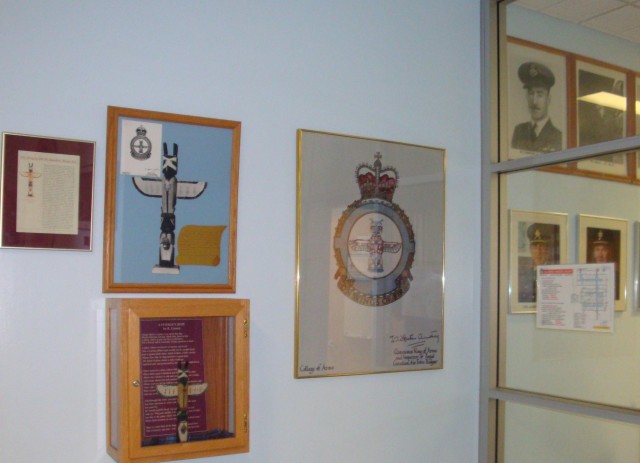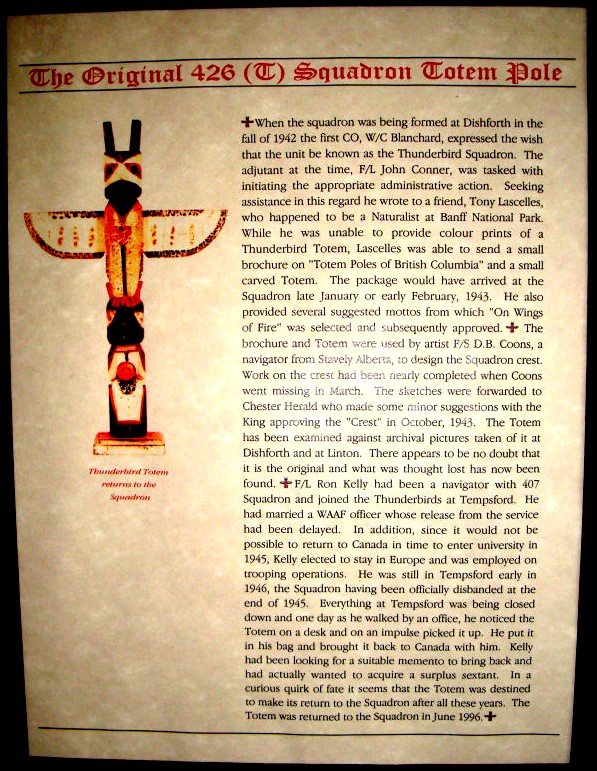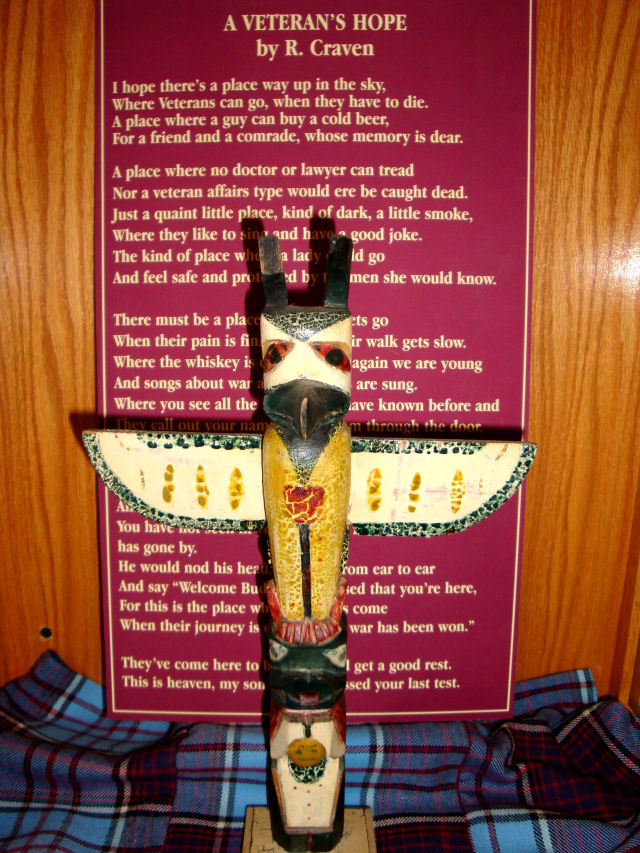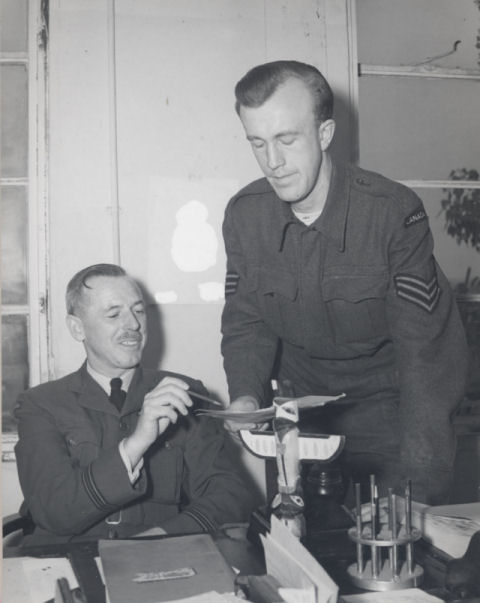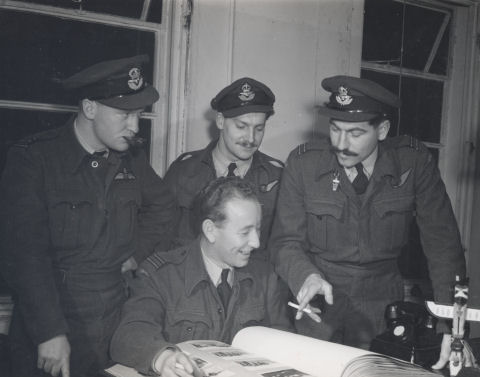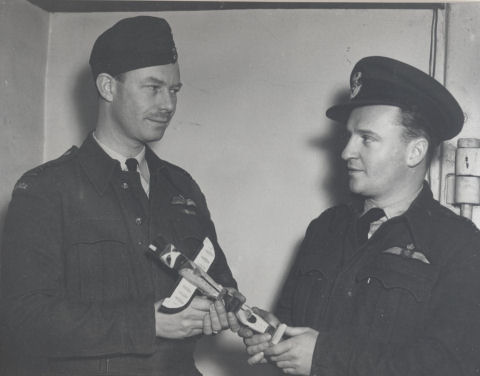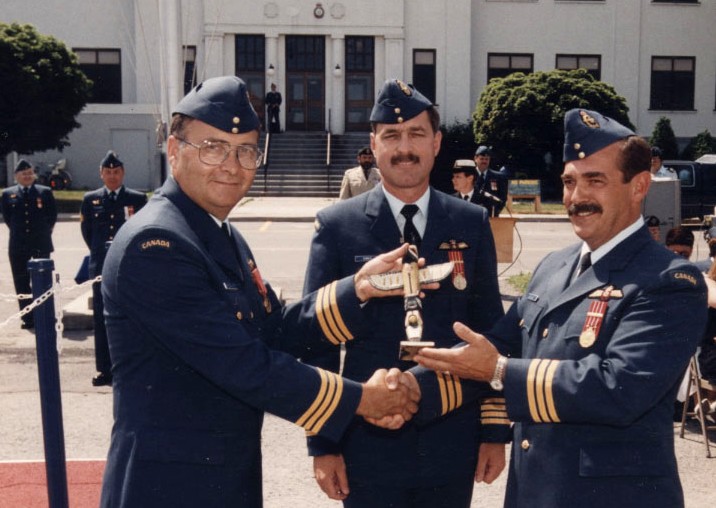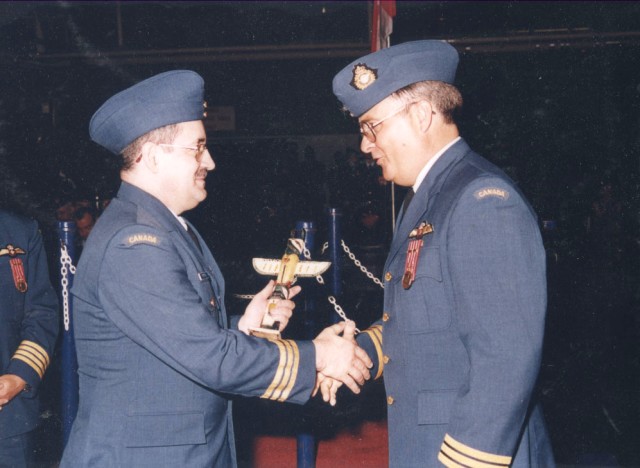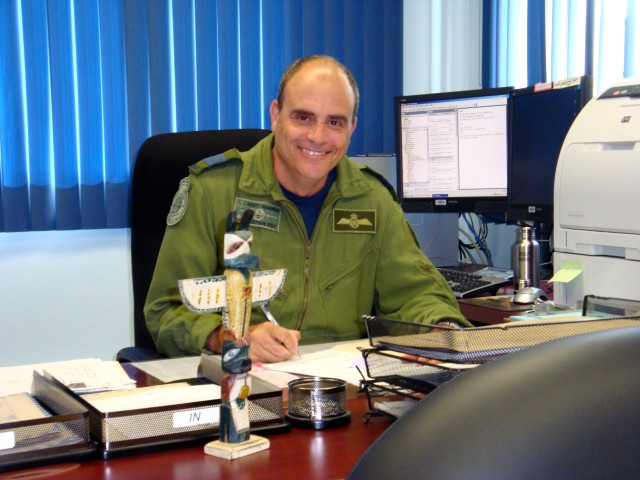"The Squadron's First Totem"
The squadron's first totem today has a place of honour at the entrance to the headquarter's wing of Dishforth Building. It is appropriate that the portrait of W/C Blanchard seems to look down upon it from his spot in the hall. | |
| When the squadron was being formed at Dishforth in the fall of 1942 the first CO, W/C Blanchard, expressed the wish that the unit be known as the Thunderbird Squadron. The adjutant at the time, F/L John Conner, was tasked with initiating the appropriate administrative action. Seeking assistance in this regard he wrote to a friend, Tony Lascelles, who happened to be a Naturalist at Banff National Park. While he was unable to provide colour prints of a Thunderbird Totem, Lascelles was able to send a small brochure on "Totem Poles of British Columbia" and a small carved Totem The package would have arrived at the Squadron late January or early February, 1943. He also provided several suggested mottos from which "On Wings of Fire" was selected and subsequently approved. The brochure and Totem were used by artist F/S D.B. Coons, a navigator from Stavely Alberta, to design the Squadron crest. Work on the crest had been nearly completed when Coons were missing in March. The sketches were forwarded to Chester Herald who made some minor suggestions with the King approving the "Crest" in October, 1943. The Totem has been examined against archival pictures taken of it at Dishforth and at Lipton. There appears to be no doubt that it is the original and what was thought lost has now been found. F/L Ron Kelly had been a navigator with 407 Squadron and joined the Thunderbirds at Tempsford. He had married a WAAF officer whose release from the service had been delayed. In addition, since it would not be possible to return to Canada in time to enter university in 1945, Kelly elected to stay in Europe and was employed on trooping operations. He was still in Tempsford early in 1946, the Squadron having been officially disbanded at the end of 1945. Everything at Tempsford was being closed down and one day as he walked by an office, he noticed the Totem on a desk and on an impulse picked it up. He put it in his bag and brought it back to Canada with him. Kelly had been looking for a suitable memento to bring back and had actually wanted to acquire a surplus sextant. In a curious quirk of fate it seems that the Totem was destined to make its return to the Squadron after all these years. The Totem was returned to the Squadron in June 1996. |
| A Veteran's Hope I hope there's a place way up in the sky Where Veterans can go, when they have to die A place where a guy can buy a cold beer For a friend and comrade, whose memory is dear A place where no doctor or lawyer can tread Nor a Veterans Affairs type would ere be caught dead Just a quaint little place, kind of dark, a little smoke Where they like to sing and have a joke The kind of place where a lady could go And feel safe and protected by the men she would know There must be a place where old vets go When their pain is finished and their walk gets slow Where the whiskey is old and once again we are young And songs about war and comrades are sung Where you see all the fellows you have known before and They call out your name as you come through the door Who would buy you a drink, if your thirst should be bad And say to the others "He was quite a good lad." And then through the mist, you spot an old guy You have not seen in years and you realise that the past has gone by He would nod his head and grin from ear to ear And say "Welcome buddy, I'm pleased that you're here, For this is the place where veterans come When their journey is over and the war has been won. "They've come here to be happy and get a good rest This is heaven my son, you've passed your last test. R.Craven |
| |
The Totem can be seen here on the desk of the Adjutant F/L W.H. Walker of Port Hope, ON, who held that position from Feb-Oct '44. Sgt Thomas Plunkett of Montreal was the NCO in charge of the orderly room, arriving at Dishforth in Oct '42 and remaining with No 426 as long as it was a bomber squadron. He provided administrative continuity through nearly three years of intense operational activity and personnel turnover, and was Mentioned in Despatches. | |
| |
This photo was taken in Nov '44 with the arrival of a new Adjutant, F/L A.F.J. Mackell of Ottawa (seated). He is receiving a briefing from W/C C.W. Burgess, P/O R. Galloway (RAF) and F/L J.R. Wiebe. | |
| |
Passing of the Totem, 2 Jan '45. W/C Fitzroy C. Carling-Kelly (left) of Toronto, receives the Totem from W/C Charles W. Burgess, also of Toronto. On completing his tour of operations Burgess was awarded the Distinguished Flying Cross for his leadership, courage and devotion to duty. He retired in '67 with the rank of Air Commodore. Carling-Kelly had relinquished the rank of Group Captain so he could return to operations, and was posted to No 426, but was wounded and shot down during a raid on Stuttgart, 28-29 Jan '45. He received the Air Force Cross for meritorious service during the war and retired in '63 as a Group Captain.
| |
| |
12 Jul 96, only two months after the totem was returned, Change of Command Parade, from LCol J.D.R. Bourque to LCol L.W. Hoddinott, Col Dumas presiding. | |
| |
2 Jun 99, outgoing CO LCol L.W. Hoddinott passes the totem to incoming CO LCol J.P.M. Fortin. | |
| |
The current CO, LCol J.G.C. Roy, dealing with the never ending paperwork, while the squadron's oldest relic stands guard. | |















































